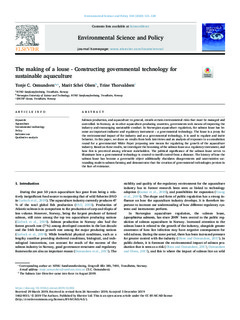| dc.contributor.author | Osmundsen, Tonje Cecilie | |
| dc.contributor.author | Olsen, Marit Schei | |
| dc.contributor.author | Thorvaldsen, Trine | |
| dc.date.accessioned | 2020-01-03T09:41:26Z | |
| dc.date.available | 2020-01-03T09:41:26Z | |
| dc.date.created | 2020-01-02T11:03:33Z | |
| dc.date.issued | 2020-02 | |
| dc.identifier.citation | Environmental Science and Policy. 2020, 104 121-128. | nb_NO |
| dc.identifier.issn | 1462-9011 | |
| dc.identifier.uri | http://hdl.handle.net/11250/2634725 | |
| dc.description.abstract | Salmon production, and aquaculture in general, entails certain environmental risks that must be managed and controlled. In Norway, as in other aquaculture-producing countries, governments seek means of improving the industry and encouraging sustainable conduct. In Norwegian aquaculture regulation, the salmon louse has become an important indicator and regulatory instrument – a governmental technology. The louse is a proxy for the environmental impact of the industry and as a governmental technology, it is used to regulate and incite behavior. In this paper, we draw on results from both interviews and an analysis of responses to a consultation round for a governmental White Paper proposing new means for regulating the growth of the aquaculture industry. Based on these results, we investigate the becoming of the salmon louse as a regulatory instrument, and how this is perceived among relevant stakeholders. The political significance of the salmon louse serves to illuminate how a governmental technology is created to instill control from a distance. The history of how the salmon louse has become a governable object additionally elucidates disagreements and uncertainties surrounding modern salmon farming and demonstrates that the creation of governmental technologies persists in the face of resistance. | nb_NO |
| dc.language.iso | eng | nb_NO |
| dc.rights | Attribution-NonCommercial-NoDerivatives 4.0 Internasjonal | * |
| dc.rights.uri | http://creativecommons.org/licenses/by-nc-nd/4.0/deed.no | * |
| dc.subject | Aquaculture | nb_NO |
| dc.subject | Governmental technology | nb_NO |
| dc.subject | Policy | nb_NO |
| dc.subject | Indicator use | nb_NO |
| dc.subject | Qualitative analysis | nb_NO |
| dc.title | The making of a louse - Constructing governmental technology for sustainable aquaculture | nb_NO |
| dc.type | Journal article | nb_NO |
| dc.type | Peer reviewed | nb_NO |
| dc.description.version | publishedVersion | nb_NO |
| dc.rights.holder | © 2019 The Authors. Published by Elsevier Ltd. This is an open access article under the CC BY-NC-ND license (http://creativecommons.org/licenses/BY-NC-ND/4.0/). | nb_NO |
| dc.source.pagenumber | 121-128 | nb_NO |
| dc.source.volume | 104 | nb_NO |
| dc.source.journal | Environmental Science and Policy | nb_NO |
| dc.identifier.doi | https://doi.org/10.1016/j.envsci.2019.12.002 | |
| dc.identifier.cristin | 1765037 | |
| dc.relation.project | Norges forskningsråd: 234139 | nb_NO |
| dc.relation.project | Norges forskningsråd: 254849 | nb_NO |
| cristin.unitcode | 7566,2,0,0 | |
| cristin.unitname | Sjømatteknologi | |
| cristin.ispublished | true | |
| cristin.fulltext | postprint | |
| cristin.qualitycode | 1 | |

